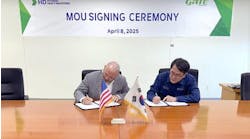Eldon Ball • Houston
In this issue,Offshore brings you an exclusive report from BP on how the company met the many large scale challenges of developing its Thunder Horse deepwater field in the Gulf of Mexico.
In December 2008, BP started production from the third and fourth wells at the Thunder Horse South field at more than 200,000 boe/d. The company plans to start-up additional production from wells in the Thunder Horse North field this year. BP operates Thunder Horse with 75% ownership. ExxonMobil has 25%.
Every major feature of Thunder Horse – from discovery to production – has required BP and the industry to develop new capabilities, systems, and equipment, and required a combination of applied research and development, discipline, and focus, saysDan Replogle, Thunder Horse vice president. “The challenges of Thunder Horse brought out the best in our people and the best in the industry.”
“Thunder Horse’s current production is a significant new source of US domestic energy, and is the second largest producing oil field in the US,” saysNeil Shaw, BP senior vice president for Gulf or Mexico. “Thunder Horse has pushed the frontiers of deepwater technology that will be critical to our next phase of deepwater projects and to supplying America’s energy needs.”
Sitting in 6,000 ft (1,829 m) of water about 150 mi (241 km) offshore, theThunder Horse production-drilling-quarters (PDQ) semisubmersible is the largest production semi ever built, with a total displacement of 130,000 tons (117,934 metric tons). The topsides area of Thunder Horseis the size of about three football fields, and is packed with equipment and systems to treat and export 250,000 b/d of oil plus associated gas.
“Thunder Horse has set new levels for deepwater exploration and production,” saysAndy Inglis, BP’s chief executive of Exploration and Production. “With scores of new pieces of equipment or processes incorporated into the project, Thunder Horse has driven research and development efforts in many areas, including imaging and reservoir surveillance, drilling and completions equipment, and subsea and topsides production equipment.”
Get the full report from BP, beginning onpage 42.
Rig market adjusts to economy, oil price
At the current oil price, the demand for all types of offshore rigs will remain flat. As new units are delivered into a flat market, fleet utilization will slide. Currently, worldwide offshore rig utilization stands at 87.6% as 647 of the world’s 739 jackups, semis, drillships, barges, tenders, submersibles, and arctic rigs are contracted.
That’s the situation facing offshore drillers, asJustinSmith of ODS-Petrodata reports in this month’s issue.
A total of 180 rigs currently are under construction and 86 do not yet have contracts, he points out. Some 54 of the 76 jackups under construction are without contracts, while only 12 of the 55 semis and 16 of the 43 drillships under construction are without contracts. An oil price of $50 to $60/bbl would ensure that most of the new rigs eventually would find work, he says, although day rates may come down to coincide with oil price.
Read his full report, beginning onpage 32.
Offshore Asia conference breaks new ground
The 2009 Offshore Asia Conference & Exhibition will take place March 31-April 2, 2009, at the IMPACT Exhibition and Conference Center in Bangkok, Thailand.
The Department of Mineral Fuels, Ministry of Energy, Thailand, has endorsed the conference, and PTT Exploration and Production Plc. (PTTEP) will be hosting.
Dr. Kurujit Nakornthap, director-general of the Department of Mineral Fuels, and Anon Sirisaengtaksin, CEO of PTTEP, will address the conference at the official opening keynote session.
“We are delighted Thailand will be hosting Offshore Asia 2009,” says Dr. Nakornthap. “The event will bring immense benefits to the regional offshore oil and gas industry, and the country. Important subjects will be discussed during the three-day conference. We look forward to a successful and informative event.”
Full details start onpage 56.
To respond to articles in Offshore, or to offer articles for publication, contact the editor by email ([email protected]) or fax (1-713-963-6296).


